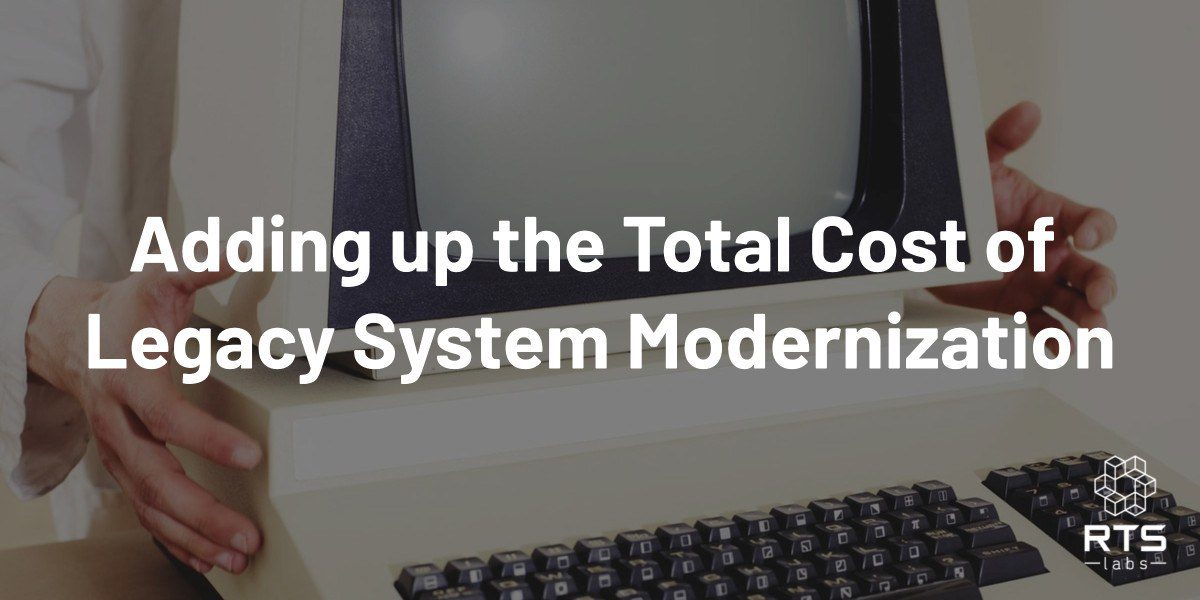What are you responsible for achieving in your role and in your organization? If you are a Chief Information Officer or other IT leader, the answer to this question most likely falls somewhere between “continuous improvement for my organization” and “putting out fires.” Modernizing your legacy systems can help you achieve both at the same time IF done right. But there are two large hurdles every IT leader faces when talking about modernization: resistance to change and cost. The thing most organizations miss when they start adding up the total cost of legacy system modernization is all the hidden costs of NOT modernizing …
The benefits of software modernization are clear – so clear that RTS Labs has put together dedicated teams for creating the tools clients need to develop automated, efficient environments through legacy system modernization. The system modernization teams have seen firsthand how critical digital transformation is when making enterprise updates, so they know what’s at stake for our clients.
But for some CIOs and IT chiefs, it boils down to the bottom line: How are we going to pay for this – and how are we going to justify it? So, let’s take a deeper dive into what are the costs of legacy modernization – and why it is most likely worth its weight in gold for your organization.
First, look at legacy modernization as a cost-benefit analysis
Asking what legacy system modernization costs is the IT version of putting the cart before the horse. Let’s flip the conversation. Instead of asking how much legacy modernization costs, the real question to ask yourself is how much maintaining legacy systems costs.
Daniel Newman at Future of Work reports that large enterprises can spend as much as 80 percent of their IT budget on maintaining and operating legacy systems – which are often both inefficient and completely outdated. “Because these systems were initially created and customized for now obsolete needs, taking inventory of what still works and what doesn’t allows companies to identify which processes are no longer relevant,” Newman writes. “Only applications deemed critical to business are then modernized; the others are simply retired, saving time and money on maintenance.”
Modernization, in other words, is not solely about ripping and replacing your entire enterprise IT infrastructure. It’s about finding what doesn’t work and updating those components to modern, efficient, profitable standards. Without this process, enterprises face maintaining a double cost: the manpower required to keep these systems up and the lost opportunity for growth with such a large percentage of the IT budget being spent on operation and maintenance.
In 2018, the U.S. government spent over three-quarters of its IT budget on operations and maintenance rather than modernization efforts. Shawn McCarthy, research director for IDC Government Insights, says that’s the highest percentage he has ever seen. Not only that, but the cost simply isn’t worth it when compared to legacy modernization.
“Moving an older system isn’t just about the cost of the hardware and software … It will be expensive, but when you look at what the legacy system is costing you 2-3-4 years down the road, we have seen most of these able to pay themselves off in a 2-to-3 year period. It’s definitely worth having that conversation and I think the CFO needs to be a part of that conversation.” ~Shawn McCarthy, Research Director, IDC Government Insights
How can you avoid the same kind of spending breakdown for your enterprise? Giving your legacy software and systems a digital update is certainly a great place to start.
In the RTS Labs 101 guide to legacy system modernization, we discuss how having up-to-date, integrated, user-friendly software and systems in place will almost certainly save your organization on transactions, downtime and more. Javelin Strategy & Research found that mobile and online banking transactions cost financial institutions just $0.10 each. In contrast, the cost for in-person transactions is $4.25 each. What this study clearly demonstrates is that with older systems and software, you may think you’re spending less, but you’re actually spending much more on other overhead expenses in the long run.
Next, set up goals according to your and business needs and IT budget
There are a couple of critical elements to keeping your modernization process as cost efficient as possible. First, remember that your goal in legacy system modernization is to improve your enterprise services. For some, this means improving the end customer’s experience by integrating as many processes as possible. For others, it means simplifying the application development process so that the entire enterprise can see a better time to market.
Whatever the case, be sure you start with your business needs rather than the technology you’d like to implement. With the reverse, you risk getting a bad case of tunnel vision on a technology stack you’ve already set your sights on but may not actually need. The result is a higher budget and wasted dollars. In a phrase, legacy modernization is not just an IT endeavor; it is a business endeavor.
Second, if you are constrained by IT budget issues, don’t worry about doing everything at once. You don’t need to rip out your entire IT infrastructure in order to start seeing effective changes to your systems and software.
Instead, start with an incremental approach to modernizing your legacy system. Work on new applications with a DevOps approach and see what that does for your time to market. Focus on the functionality of your frontend and see what it does for customer satisfaction. With incremental modernization you can show the proof of the process and then bite off more down the line. You can also look at a hybrid approach for replatforming your systems instead of initiating a complete overhaul.
The bottom line is your bottom line
Software modernization may carry a large price tag up front, but it will save on labor and maintenance costs in a matter of months. By the same token, maintaining legacy systems may look inexpensive, but you are likely losing out on growth opportunities to your competition.
“The biggest challenge for enterprises is weighing up present day investment, cost, complexity and ROI versus the maintenance of old systems,” writes Rajneesh Kumar at Digital Doughnut. “The dilemma is choosing between short term problems and risks and long term benefits.” It’s a cost-benefit analysis, in other words.
Looking into legacy system modernization is not so much about if you should undertake a modernization project as it is about how you will go about it. Budget constraints and profitability are real concerns, so you want to be sure that however you approach legacy system modernization will improve your bottom line in the long run.
For a more thorough guide to all the different considerations and decisions that go into a successful legacy system modernization project, check out these additional articles and guides.
Additional Reading:
Your 101 Guide to Legacy Systems Modernization
True Digital Transformation: Why Legacy Software Modernization Is More Than an Update






